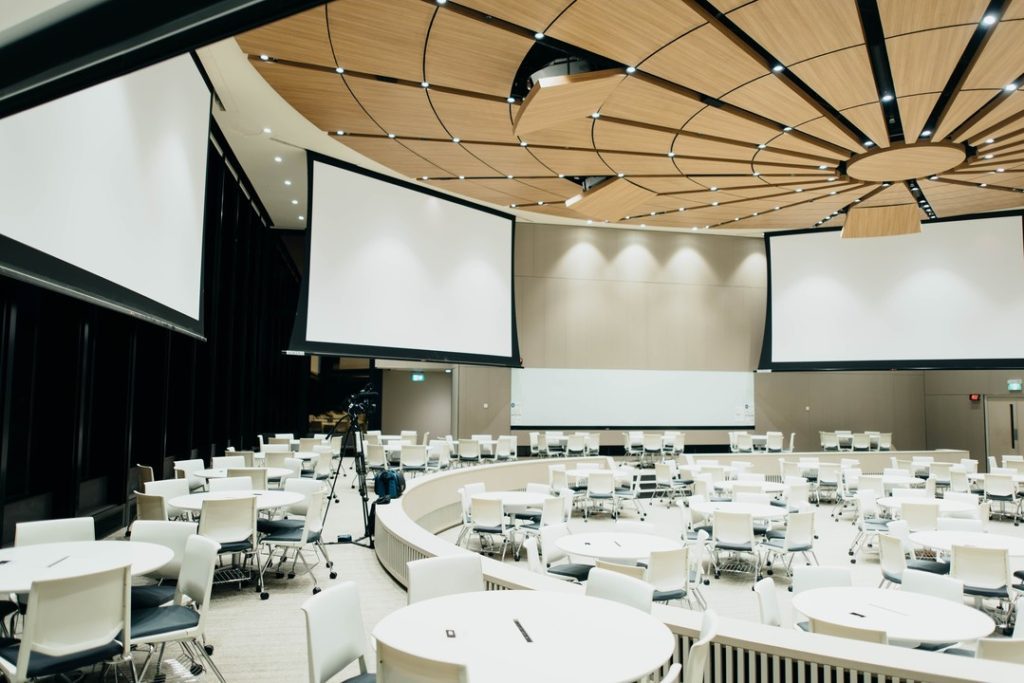Over the past few months, one thing has become undeniably clear – Covid has affected every aspect of our lives and has caused many companies to take a step back and re-evaluate the modern conference room. The first phase of many “back to work” plans includes only allowing certain teams in the office on certain days, or some sort of percentage-based plan, so what happens to the conference room in the meantime? As groups return to the office, conference rooms will be needed, and below are some of the top trends we are seeing for the modern conference room.
In general, the modern conference room needs a camera, microphone, speaker, and display. None is more important than the other in terms of creating a good conferencing experience and each item is scalable to accommodate the size of the room. In smaller rooms you might see a 50 – 60” display with a soundbar, microphone, and camera combo device mounted under it. These units are great for saving space and maximizing efficiency with installation and setup. In larger rooms, you might require an 80 – 100” display with microphones and speakers installed in the ceiling, allowing the sound to be captured over a larger area. While the technology and prices can vary between the two room types, they still hold the fundamental values of creating a great experience.
Automation within the conference room has become one of the best things to enhance the user experience by minimizing physical interaction. Most designers are planning around how nice it would be, if when you walked into a room, the system just turns on by itself, registers that you’re in there for a meeting, and starts your meeting up for you. Automation to do all of this and even to assist if you leave and forget to turn the system off can now be done with some inexpensive sensors and AV/IT coordination.
Cost is always a major factor when planning a conference room upgrade. While the natural inclination might be to trade that projector and screen in for a brand-new flat panel, that may not bring a great ROI in the long run, specifically if that’s the only thing you’re upgrading. Creating a great audio experience in your room can be simple and cost effective. Imagine having a face-to-face conversation with someone and you’re only picking up every third word they say. Is your first thought going to be about how they look or the fact that you cannot hear them. Always be sure your wallet is aimed at items that will help the goal of the conference room, which at its most basic need, is communication. Great audio quality is a definite need in every conference room.
One of the biggest notable trends for conference room, large and small, has been the uptick on UC specific spaces. “Zoom Room” has been out for a few years now, but the “Teams Room” is catching up in popularity and functionality. These rooms allow for a “one-touch conferencing” solution that minimizes user interaction and expedites efficiency as it does not require users to bring their laptop to set up the meeting. The device, typically a touch panel tied to a small form factor PC, is given its own Microsoft/Outlook account and then becomes the meeting “host”, while the other users are simply just invited to the meeting. For a business that uses Teams or Zoom as their sole conferencing platform, these cost-effective room solutions are a great add-on to any small meeting room environment.
When planning for your main conference room, exercise caution when spec’ing these systems, as most are typically locked down to whatever platform is initially chosen and will not work with other platforms. While potentially more expensive, it may be wise to invest in a more universal system for your main conference space. If your conference room is used by multiple parties, you’re existing clients, potential clients, and outside vendors to name a few, then integrating a universal system will allow ease of use to multiple end users, making your main conference room a more desirable and easier to use meeting location.



